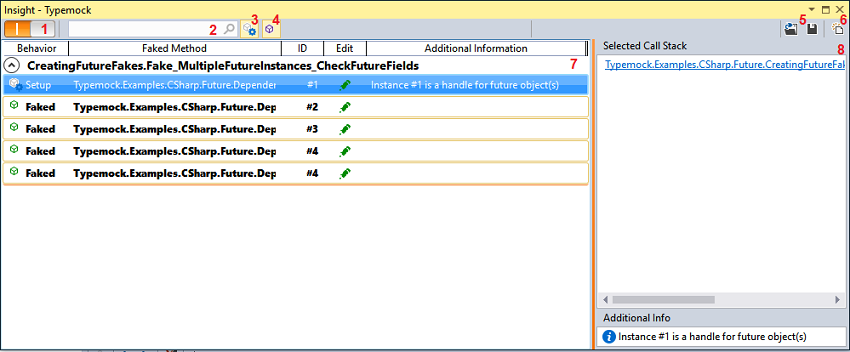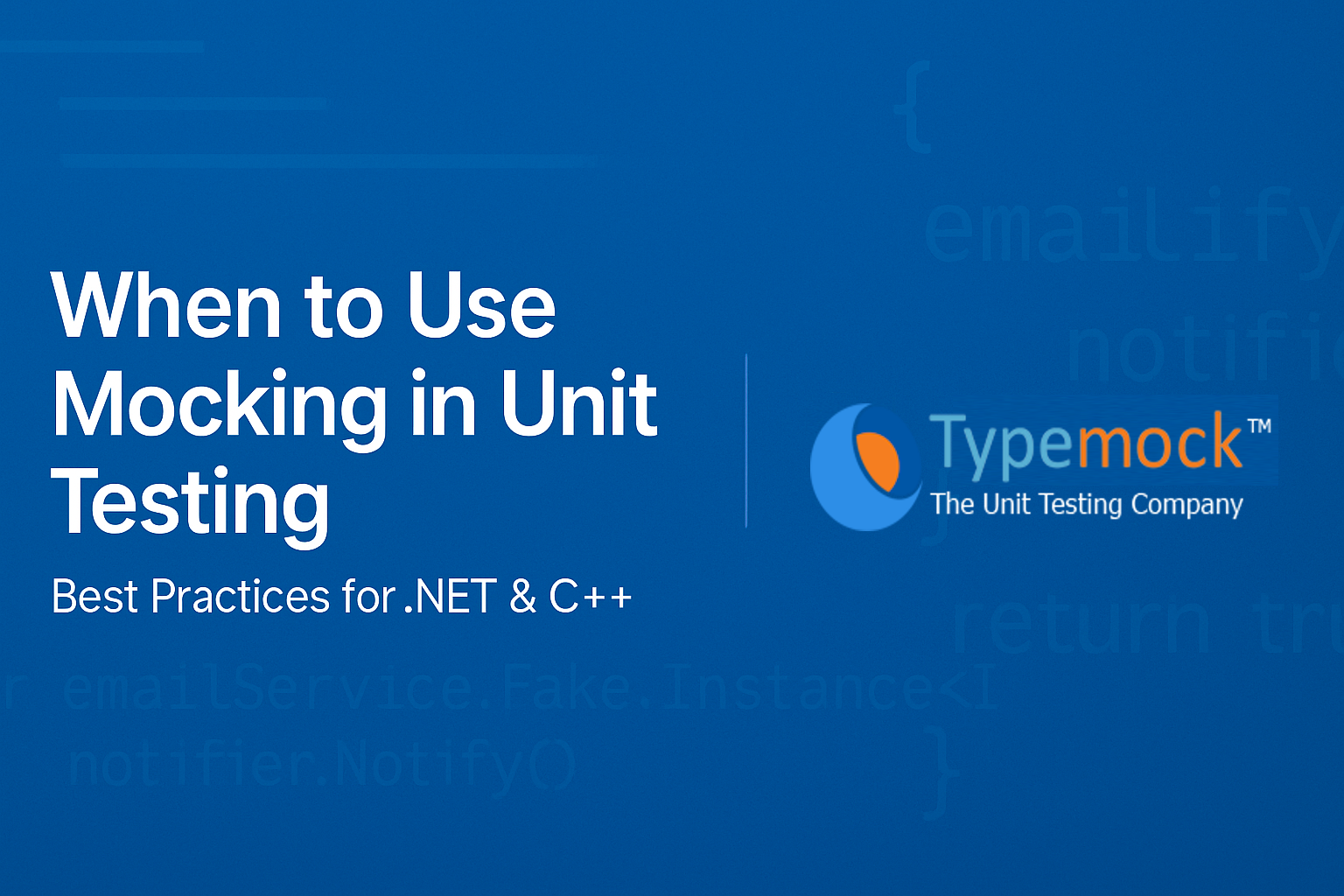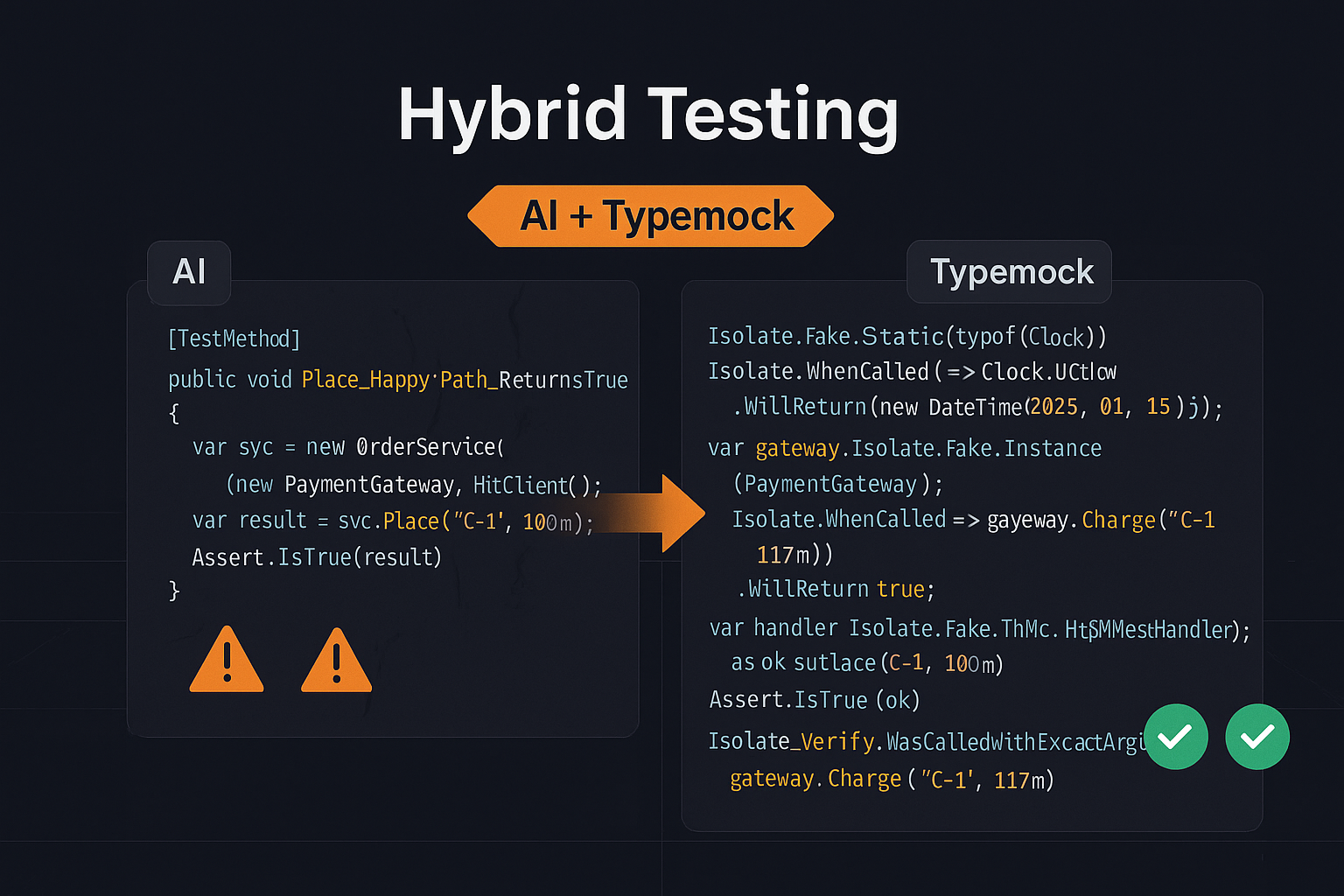Best Practices for .NET & C++ Developers
Why This Matters
Mocking is a superpower in modern unit testing, but like any power, it can be overused.
Used wisely, mocks make tests lightning-fast and clean. Used recklessly, they create an illusion of stability while real bugs hide in production.
In this post, we’ll explore when to use mocking in unit testing, when it hurts, and how to build a healthy test suite that blends both isolation and reality.
👉 Haven’t read our intro yet? Start with Learn the basics of mocking before diving deeper
When to Use Mocking in Unit Testing
Mocking shines when your code interacts with anything outside your control:
- External APIs or microservices
- File systems, databases, or queues
- Time, randomness, or system state
- Legacy dependencies that are expensive or slow to instantiate
Mocks give you deterministic, isolated, repeatable tests – perfect for agile teams and CI pipelines.
Example (.NET / MSTest)
|
1 2 3 4 5 6 7 8 9 10 11 |
[TestMethod] public void Should_Send_Notification_Without_Hitting_Real_Service() { var email = Isolate.Fake.Instance<IEmailService>(); Isolate.WhenCalled(() => email.Send("dev@typemock.com")) .WillReturn(true); var notifier = new Notifier(email); Assert.IsTrue(notifier.Notify("dev@typemock.com")); } |
This test runs instantly, without any real email traffic.
You’ve isolated the logic that matters and ignored the infrastructure that doesn’t.
Example (C++ / Isolator++)
|
1 2 3 4 5 6 7 8 9 10 11 |
TEST(Legacy, Should_Process_Data_Without_Hitting_Database) { Isolator a; auto db = a.Fake.Instance<IDatabase>(); a.CallTo(db->SaveRecord()).WillReturn(true); DataProcessor processor{db}; ASSERT_TRUE(processor.Process()); } |
Here the fake database mimics expected behavior, letting you verify logic without connecting to the real DB.
When Not to Mock
If everything in your system is mocked, you’re not testing reality, you’re just validating assumptions.
Mocks hide bugs when used in integration scenarios.
Avoid mocks when:
- You’re testing data integrity or schema mapping
- You need to verify serialization, configuration, or endpoints
- You’re testing framework behavior (Entity Framework, gRPC, etc.)
- You’re writing integration or end-to-end tests
⚠️ Over-mocking leads to “green builds” that fail in production.
The Rule of Three
A simple way to decide whether to mock:
- Is it slow? → Mock it.
- Is it external? → Mock it.
- Is it internal and stable? → Test it directly.
This keeps your suite fast without faking the world.
Best Practices for When to Use Mocking in Unit Testing
✅ Keep one fake per test.
✅ Name fakes clearly (fakeGateway, mockRepo).
✅ Avoid mocking constructors or statics unless necessary.
✅ Use WillDoInstead() only when you need custom behavior.
✅ Add one integration test per module to validate the real flow.
✅ Use Isolator Insights to confirm mock behavior and track faked method calls visually.
Use Isolator Insights to Visualize Your Mocks
Even with the best practices above, it can be hard to see what’s really happening inside your tests.
That’s where Typemock Isolator Insights comes in.
Insights gives you a real-time view of:
- Which methods and objects were faked
- How your mocks interact during test execution
- Where setup or verification might be missing
You can instantly trace your test flow, verify mock behavior, and debug unexpected calls, all without adding extra logging.

💡 Use Insights whenever a test fails or behaves unexpectedly. It helps you confirm whether your mocks are configured correctly or if the issue lies in your real code.
How Typemock Helps
Most frameworks stop where your real problems start – sealed, static, or private methods, or deep legacy C++ code.
That’s where Typemock excels.
- Typemock Isolator for .NET lets you fake anything – no refactoring required.
- Isolator++ for C++ isolates legacy code and static functions with a simple, modern API.
- Both integrate smoothly with your CI and test frameworks.
👉 Download Isolator++ Free or Isolator dotNet and start testing the untestable.
Frequently Asked Questions
Mock dependencies that are slow, external, or non-deterministic. Avoid mocking your own logic.
Yes, the concept is the same. Typemock provides native APIs for each language.
Absolutely. Typemock Isolator and Isolator++ are designed to do exactly that safely.
No. Mocking isolates units of logic; you still need integration tests for full system confidence.
Conclusion
Mocking isn’t about avoiding the real world – it’s about controlling it while you verify your logic.
A balanced testing strategy combines mock-based unit tests with selective integration tests, keeping your builds fast and reliable.
Use mocks wisely, and your tests will be your safety net – not your blindfold.
💡 Next: Learn the basics of mocking learn the basics behind mocks, fakes, and stubs.
You can also read Martin Fowler’s classic post on Mocks Aren’t Stubs for deeper context.




